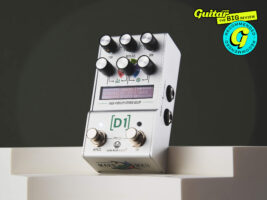
Walrus Audio Mako Series MkII D1 review – the do-it-all high-fidelity delay pedal gets glitchy
$399/£379, walrusaudio.com
Being on top of the world is great, but then the world moves and you fall off. Walrus Audio knows this. It’s been half a decade since its Mako Series D1 was crowned Guitar.com’s pedal of the year, and a lot has changed in that time – notably the rise of weird, glitchy, low-fidelity delay pedals. So where does that leave the king of non-weird, non-glitchy, high-fidelity delay pedals?
READ MORE: Walrus Audio Fundamental Ambient review – is this the best budget reverb pedal on the market?
Of the four stompboxes in the Mako Series, the D1 was perhaps the one that needed a MkII version most. And here it is, with a new interface built around an LED screen… and a new emphasis on lo-fi soundscaping adventures.
Image: Adam Gasson
Walrus Audio Mako Series MkII D1 – what is it?
First up, Walrus Audio is an Oklahoma City pedal company with an expansive product range and a cute logo. The original Mako Series was its first leap into high-end multi-mode stereo effects using SHARC digital processors, with the D1 delay leading the line – followed soon after by the R1 (reverb), M1 (modulation) and ACS1 (amp and cab simulation). The D1 had an upgrade in 2022, but don’t confuse v2 with MkII – this is a much more significant evolution of the whole line.
This new Mako generation is mostly about the interface, with the three toggle switches across the middle replaced by that two-inch LED display, which is controlled by a row of digital encoders (basically knobs without pointers) above it. This allows for a much deeper level of control, with all the advanced parameters accessible via a couple of prods and tweaks.
But there are also new models – and in the case of the D1 that means ‘grain’, an algorithm that chops up your signal and spits it out in all directions with the option of an octave up, an octave down or both. If you’ve got an itch for the glitch, here’s where you’ll find your sonic scratching stick.
The rest is as before: the top row of knobs covers delay time, repeats and mix, the right-hand footswitch is for tap tempo, and you can hit both footswitches together to move through three presets. Again there are three banks of those (now accessed from the screen), so you can store and recall nine different sounds in total – or 128 if you connect a suitable MIDI device. And one more important feature is unchanged: the little walrus logo at the bottom.
Image: Adam Gasson
Walrus Audio Mako Series MkII D1 – in use
This was never going to be an ultra-simple device… but the display has added a layer of versatility without adding a layer of complexity, and that’s quite a feat in itself. The whole interface is clear, logical and easy to get your head around – as long as you’re not the sort of person who panics at the sight of a third knob on a fuzz box.
Here’s the key: while the Mako Series is all about presets, navigation of the main controls is no harder than it would be with a fully manual pedal. Turn the central encoder to pick a delay mode, adjust the three top knobs to get the basics how you want them, and you’re never going to be far from where you want to be.
On the default screen, the two outer encoders are also ready to be deployed right off the bat: the left one for adjusting modulation rate, the right one for BPM. Yes, this is the same as delay time, but presented in a way that allows you to sync it to a backing track. That’s smart, that is.
And to get to the other variables? Simply push down on the left encoder to cycle through the six options: modulation depth, rate and wave shape, plus age (signal degradation), tone (progressive filtering) and stereo spread. You get a few more by pushing the right encoder; these vary according to the delay mode.
Pressing the middle and left encoders together takes you to the preset banks, and the only other thing you need to know is that there are master settings – bypass mode, screen brightness and so on – accessed by pressing middle and right. And when I say “need to know”, I mean “don’t really need to know”.
Image: Adam Gasson
Walrus Audio Mako Series MkII D1 – sounds
In terms of conventional delay sounds, there wasn’t a lot wrong with the old D1, especially after the v2 update, so it could be argued that the MkII model doesn’t have a great deal of work to do here. Sure enough, there’s nothing noticeably new about the core tones in digital, modulated, vintage, dual and reverse modes. They’re big on clarity, low on background hiss, and superbly convincing at pretty much everything they do. The reverse effect in particular is as good as I’ve heard.
But what’s really striking is how much of a difference that enhanced interface has made. Having independent control over modulation rate and depth allows this pedal to get closer to the sound of a real Deluxe Memory Man than the old one did – like, uncannily close – while those extra fine-tuning powers open up interesting new possibilities in the dual and reverse modes. It’s a shame the attack knob has been sacrificed – this was a nice way to give repeats a softer edge without making them dull – but I’ll be honest, with so many other factors to mess about with I almost didn’t notice it was gone.
And so we come to the granular delay. Your extra variables on the right encoder here are grain size, mix (between normal and messed-up repeats) and pitch, and this latter includes five options: standard, octave up, octave down, reverse (with no pitch-shift) and random (bouncing between up and down octaves). It might have been nice to see one or two other intervals on offer – fifths are always a giggle – but what really matters is that the sounds are all good, and all usable.
The obvious reference point here is Walrus’s own Fable ‘granular soundscape generator’ – but while that pedal’s all-mono algorithms have a tendency to get somewhat mushy, there’s none of that going on with the MkII D1. Just try the octave up effect running into two amps with stereo spread at maximum – it’s fluttery, skittery, ear-bewitching magic.
Image: Adam Gasson
Walrus Audio Mako Series MkII D1 – should I buy one?
It’s hard to see how this pedal could be any better in terms of the quality and tweakability of its effects – most notably the faux-analogue and reverse delays, and most rewardingly when used in stereo – but you could argue that what really sets it apart from most rivals is that it packs all of those sounds into a genuinely compact enclosure.
And while it can’t match a dedicated glitch machine when it comes to the eccentric stuff, the new grain mode adds an extra dimension of real substance. I’d love to hear that taken further with more manipulation options – something for a future firmware update?
Walrus Audio Mako Series MkII D1 alternatives
If you’re after a multi-mode all-rounder, the D1’s main rivals include the Strymon TimeLine ($449/£399), Source Audio Nemesis ($329/£299) and Boss DD-500 ($406.99/£379). But if you just want the strange and unearthly stuff, a better starting point might be the Pladask Elektrisk Baklengs ($255), Red Panda Particle 2 ($329) or Chase Bliss Audio Habit ($399).
The post Walrus Audio Mako Series MkII D1 review – the do-it-all high-fidelity delay pedal gets glitchy appeared first on Guitar.com | All Things Guitar.
Source: www.guitar-bass.net












